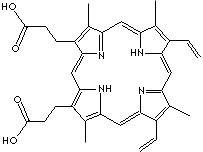PRODUCT IDENTIFICATION

H.S. CODE
TOXICITY
CLASSIFICATION
Dermatologic agent, Photosensitizing agen, Radiation-Sensitizing Agent, Tetrapyrrole
EXTRA NOTES
PHYSICAL AND CHEMICAL PROPERTIES
REFRACTIVE INDEX
Stable under ordinary conditions
EXTERNAL LINKS & GENERAL DESCRIPTION
Drug Information Portal (U.S. National Library of Medicine) - Protoporphyrin IX
http://pubchem.ncbi.nlm.nih.gov/
protoporphyrin
IX - Compound Summary
http://www.opticsinfobase.org/
Optical
imaging of fluorescent objects embedded in a tissue simulating medium
was characterized using non-contact based approaches to fluorescence
remittance imaging (FRI) and sub-surface fluorescence diffuse optical
tomography (FDOT). Using Protoporphyrin IX as a fluorescent agent,
experiments were performed on tissue phantoms comprised of typical
in-vivo tumor to normal tissue contrast ratios, ranging from 3.5:1
up to 10:1. It was found that tomographic imaging was able to recover
interior inclusions with high contrast relative to the background;
however, simple planar fluorescence imaging provided a superior
contrast to noise ratio. Overall, FRI performed optimally when the
object was located on or close to the surface and, perhaps most
importantly, FDOT was able to recover specific depth information
about the location of embedded regions. The results indicate that
an optimal system for localizing embedded fluorescent regions should
combine fluorescence reflectance imaging for high sensitivity and
sub-surface tomography for depth detection, thereby allowing more
accurate localization in all three directions within the tissue.
Local:
Porphyrin is a class of cyclic tetrapyrrolic ring structure compounds joined by
four methene bridges (=C-) through alpha-carbon atoms of four pyrroles.
Porphyrins are water-soluble biological pigments occuring widely in animal and
plant tissues to take part in important biological functions such as
metal-binding cofactors in hemoglobins in the blood of animals, chlorophyll in
plants for photosynthesis, and certain enzymes for cell respiration. Numerous
types of porphyrins can be obtained through the modification of a natural
porphyrins and total synthesis. Not only their chemical transformations through
nucleophilic and electrophilic substitution, substituent modification,
reduction, oxidation but also thier metalation and demetalation properties with
iron, zinc, copper, nickel, and cobalt give valuable biological applications in
molecular biology, fluoroimmunoassay and new pharmaceutical developments.
APPEARANCE
PURITY
95.0% min
LOSS ON DRYING
2.0% max
RESIDUE ON IGNITION
12.0% max
Pb
3ppm max
As
3ppm max
Cu
10ppm max
GHS
PICTOGRAMS

HAZARD STATEMENTS
H315
Causes skin irritation.
H319 Causes serious eye irritation.
H335
May cause respiratory irritation.
PRECAUTIONARY STATEMENTS
P261
Avoid breathing dust/ fume/ gas/ mist/ vapours/ spray.
P280 Wear
protective gloves/ eye protection/ face protection.
P302 + P352
IF ON SKIN: Wash with plenty of soap and water.
P304 + P340 IF
INHALED: Remove victim to fresh air and keep at rest in a position
comfortable for breathing.
P305 + P351 + P338 IF IN EYES: Rinse
cautiously with water for several minutes. Remove contact lenses,
if present and easy to do. Continue rinsing.
P312 Call a POISON
CENTER or doctor/ physician if you feel unwell.
P321 Specific
treatment (see supplemental first aid instructions on this label).
P332
+ P313 If skin irritation occurs: Get medical advice/ attention.
P337
+ P313 If eye irritation persists: Get medical advice/ attention.
P362
Take off contaminated clothing and wash before reuse.
P403 +
P233 Store in a well-ventilated place. Keep container tightly closed.
P405
Store locked up.
P501 Dispose of contents/container through a waste management company authorized
by the local government.
![]() Xi
Irritant
Xi
Irritant
RISK PHRASES
36/37/38 Irritating to eyes, respiratory system and skin
SAFETY PHRASES
26 In case of contact
with eyes, rinse immediately with plenty of water and seek medical
advice
36 Wear suitable protective clothing